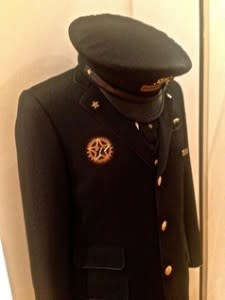A People Trained to Behave on Trains
In Japan, there is an unspoken code of conduct when commuting on trains, even though there are no clearly-stated penalties for violations. Dipa Niranjan describes what train journeys are like during a typical work day in the Greater Tokyo Area.
It’s 8 am on a Monday morning. I’m on one of Japan’s infamous rush hour trains. The salarymen are dressed in their uniform black, grey and navy blue suits. They look polished, professional and perfect.

It’s available if you need it. (Photo: Dipa Niranjan)
I am, not by choice, in extremely close proximity to several strangers. I can smell the coffee that the guy on my right has just drank. The guy on my right smells like stale cigarette smoke. The lady in front of me had an apple for breakfast. Talk about too much information.
If you’re a woman and want to avoid being packed in a small space with a bunch of random men, there’s a women’s only carriage. Somewhere.
The train stops at Sakuragicho Station, home to Yokohama’s famous Minato-Mirai district. Countless people bump into me as they alight the train. No one apologises. In Japan, there is no need to.

One of my favourite areas in Yokohama. (Photo: Dipa Niranjan)
The kiasu Singaporean in me rushes to an empty seat. Sitting is more comfortable than standing. I heave a sigh of relief. My moment of peace is short-lived. Japan has an ageing population. A polite young person in this country never gets to stay seated for long. A lot of people pretend not to notice the elderly, the injured, the pregnant or those with young children. Bad karma, I reckon.
Even though I am claustrophobic by nature, I don’t panic. Despite the madness of the experience, there is something civil about all of it. The crowd is well-behaved.
An announcement echoes through the near golden silence on the train. After a year and seven months here, my Japanese is good enough to understand it. But in case anyone didn’t, the heavily American-accented English announcement follows, “Please turn your mobile phone to silent mode and refrain from answering your phone on the train.”
And it doesn’t end there. If you want to speak to anyone on the train, you have to whisper. No laughing loudly or having audible conversations. I wonder what happens if anyone breaks the rules. I’m not sure.
Train etiquette in Japan is unusual in comparison to other countries, but it does make sense. How many times have you eavesdropped on someone’s conversation on the MRT without meaning to or even wanting to? How often have you wanted some loud excuse of a human being to just be quiet on a double-decker bus because they were making a scene?
The Japanese are also sticklers for punctuality and the trains are rarely late. In the unlikely event that a train isn’t running on schedule, you can obtain a train delay certificate to give to any authority figure as an acceptable reason for tardiness. It’s a far cry from my student days in Melbourne where the train was perpetually late.

Appearances aren’t everything, but it’s quite the uniform. (Photo: Dipa Niranjan)
Like Singapore, the Japanese rail system is also super clean and well maintained. The train conductors look immaculate in their perfectly pressed uniforms and white gloves. The Japanese take great pride in the work they do.
My stop arrives. All alighting passengers get off before boarding commuters get on. Unlike Singapore, there is no announcement telling us to let everyone get off before anyone attempts to get on. I tap my Pasmo at the turnstiles and finally breathe that overdue sigh of relief.
Later that day, I get on the train at 8.30pm for my journey home. The salarymen have loosened their ties and no longer look as perfect, polished and professional as they did in the morning. Bless their souls. Working in Japan is hard. There are no elderly on board, so I get a seat and manage to keep it.

The variety of train seat designs in Japan. (Photo: Dipa Niranjan)
I’m impressed by how salarymen can sleep while standing. The guy on my right smells like whiskey. The guy on my left has had one too many beers and is falling asleep on my shoulder. Any concept I once had about personal space has vanished. I give him a good flick to awaken him from his alcohol-induced slumber. I don’t take it personally.
I’m tired myself. I shut my eyes and fall asleep, glad that there are no ringing phones or loud chatter. Only in Japan. Only in Japan.
I only hope I wake up in time for my stop.
Top photo: The morning crush in Tokyo, tiaramontgomery
About the author
Dipa Niranjan teaches English to Japanese teenagers in the Greater Tokyo Area. Educated in the land of Kangaroos and Koalas as well as the holy city of Jerusalem, this born-and-bred Singaporean strongly believes that home is where the chicken rice is. She enjoys cooking and is often contemplating what to put in her bento for lunch.


